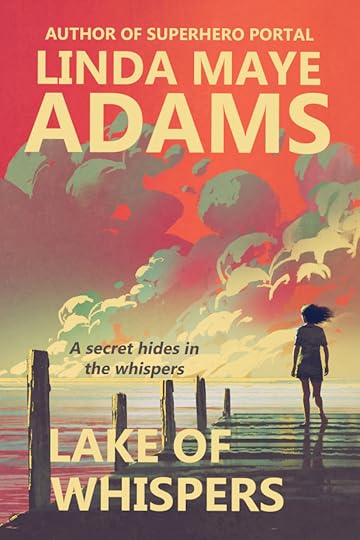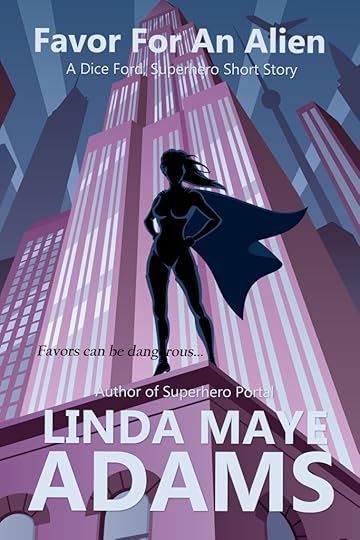Linda Maye Adams's Blog, page 22
September 6, 2021
Free Books and Short Stories
I’m winding down on the Great Challenge with my 52nd story and glad to get back to finishing up my superhero novel, Superhero Portal.
In the meantime, I’m part of two promotions where you can download a bunch of free fiction! Like we all need more books, right? Yeah, but books…
Kindle Unlimited
I’m sharing the stage with 49 other wonderful writers. There’s a little bit of something for everyone interested in reading speculative fiction. It includes:
Two superhero stories (one’s mine! I think we both used the same image artist)Urban fantasyScience fictionRomanceLooks like a lot of fun reading! Pick up your free books here: Kindle Unlimited. .
Short Fantasy Reads
If you like reading short stories, this one’s for you. It’s focused entirely on the short story, and there are 18 free stories to choose! Grab your books at Short Fantasy Reads.
June 29, 2021
What I’ve Learned About Ideas
 Three Thinkers Sitting In Front Of A Computer Screen. 3D Illustration.
Three Thinkers Sitting In Front Of A Computer Screen. 3D Illustration.A wonderful image copyright by 3DSculptor
This week marks my 10 story countdown on the Great Challenge. That means I’ve written 41 stories over the last year, a definite record for me. You’ll find many of the stories on Sci-Fi/Fantasy Books – Linda Maye Adams, though I still have more to release!
But it also taught me a lot about ideas, since I’ve had to come up with one 41 times.
Yeah, sometimes it’s been “Wait? I have to come up with another one? Again?!”
I can only imagine what it must have been like for the pulp writers, who wouldn’t be able to put food on the table if they didn’t write and finish a story.
An Idea is Not the Same Thing as a StoryThis sounds pretty straight forward, but it isn’t. I struggled with the concept on my first novel.
It was a called Remember No Evil, an amnesia story. I figured building a character from the blank slate amnesia provided would make the characterization easier to do (not true). It went great for about 100 pages, and then I got stuck. I didn’t realize it at the time, but this a common problem that no one talks about (it’s fear that hits once you get out of the beginning).
I figured I was getting stuck because something was wrong in the first part of the book, so I went back and revised to “fix” the problem. It’s actually common advice to do this for this problem, though it’s completely wrong. The result was that I’d bump into that sticking point again, go back to revise, rinse, and repeat.
I knew I should trunk the novel. Except…
I didn’t have any other ideas. That terrified me! What would happen if I did finish the book and it got accepted? Then I’d have to come up with another idea for a book!
It wasn’t until another writer and I agreed to cowrite that it knocked me out of being stuck there (though it was his idea, not mine).
An idea is just one miniscule piece of a story, and a novel is made up of hundreds of ideas. The first one is simply a bit of inspiration to get started. All ideas are creativity at play.
We Lose Creativity As We Become AdultsI read a lot of business books (which any writer should do). There’s a unbelievably huge market for how to come up with ideas. A few examples:
Brainstorming (usually done as a group, and from what I’ve read, largely done incorrectly)Mindmapping (I’ve tried this generally. Very hard keeping the inner critic out. I’m a terrible artist!)People still struggle to come up with ideas. I had to have a class to figure out how to come up with them.
We lose the ability to be creative as we grow up. As children, we come up with incredible fanciful stories when we play with our toys.
Then adult opinions start to intrude.
Adults are down to business, dealing with the day to day of life. Ideas look frivolous, even childish. I’ve had occasions where someone asked me to tell them my idea, so I did. Then they got this uncomfortable look in their eyes, like they wanted to be anywhere but with me.
Even critiques can ruin creativity. You enjoyed writing the story and thought the ideas in it were fantastic. Then you get someone who just growls and fusses at your story (which he probably does because it gives him a sense of power). But it kicks on our inner critic and the muse runs off to hide. And maybe the story ends up in the trashcan.
Is it any wonder it’s so hard to figure out how to come up with ideas?
Creating Ideas is Not a One-Size Fits AllI once worked with a writer who latched onto the concept of “What if” for idea generation. He started lecturing me that all ideas must be conceived this way.
It left me cold. “What if” doesn’t’ do anything at all for me. It doesn’t inspire me to start a story. It just lays there and plays dead.
We all get inspired by different things. I’m still figuring out what mine is and it’ll probably always be an evolving thing. I usually take pieces of things and mash them together.
Story #41 started with a message in a bottle.
I started a little research on the topic and somehow, the first thing I typed in my notes was “It’s from mermaids.”
Then Dave Farland talked about nostalgia in the 381R class I’m (finally!) finishing up.
So message in a bottle + mermaids + nostalgia.
But if you want more examples, visit How 50 Famous Authors Find Writing Inspiration (thejohnfox.com)
Sometimes Ideas Are Simply Making the DecisionPart of the Great Challenge is that I have to produce a complete short story (2K and up) by Sunday every week. That means there’s no waiting to see if the idea is right.
I have to start the story. I have to get something done.
I’ve had some not work and had to toss it out entirely. I’ve had others where it took the idea a bit of time to rattle around in my brain before I could figured out exactly what I was going to do.
But each idea had one thing in common: Decide. Now.
Maybe that’s what it was like for pulp writers.
How do you come up with ideas?
June 21, 2021
A Rough Last Week
Last week, a friend passed away following a battle with cancer. It felt very sudden to me, so I’ve been struggling to process it.
I knew I needed to get out and just do something. Connecting with nature often helps ground me.
Friday turned into an unexpected holiday, so I went down to a spice shop in Old Town Alexandria. But the store hours on the website were outdated, and I had an hour before they opened. Since it was a really nice day out, I decided to walk the waterfront.
The sky was beautiful and clear. Winds gusted off the river. Not cold, just enough to keep the heat of the sun at bay. But the winds also made the waters very choppy. I could hear it slopping against the shore where I took the photo below.
 Potomac River from the Virginia side
Potomac River from the Virginia sideThe city has done a lot of construction work around the waterfront. It used to be that I couldn’t walk very far. But during COVID-19, they finished everything up. There was a nice, wide walkway that went far enough that I walked a little too far with my bad feet. But I wanted to see it all!
The walkway followed the river. I passed a lot of people out like me, enjoying the sun and the water. The area has a lot of dog walkers and I passed a couple with a pair of dogs large enough to be ponies!
There lots of private docks, all locked up with “No trespassing” (I would have happily walked out to the end just because). The one below was pretty low in the water and looks like it was damaged by storms. There’s a lot of debris piled up on it. Though it’s not as obvious from this direction, there’s a section missing on the left. That end piece is not connected to the dock anymore.
 A private dock damaged by storms.
A private dock damaged by storms.Saturday, I got out again–no pictures. Just an outing to a local restaurant and dining out on the patio. The highlight was a little black poodle. He was absolutely adorable. The owner was giving him a treat in a cup. He stood up on his back legs, urgently gulping his treat down from the cup. Everyone stopped to look at the dog!
What did you do this weekend?
June 14, 2021
15 Awesome Tips for Fiction Writers

Photo © Andrea De Martin | Dreamstime.com
Use a style sheet to record character and place names. This helps not only the copyeditor check your work, but also helps you if you have trouble remembering how to spell a name. Style Sheets for Writers and Editors | The Editor’s Blog (theeditorsblog.net)
When you finish a scene for the day, jot down a brief summary for your future self. Just your thinking about what’s next, or even the hidden story (what the antagonist is doing). It’s just something to help you get into the creative flow next time you start. Leave a Summary for Yourself – David Perell
Take the time to learn the software tool you use for writing. It’ll save you a lot of frustration during the writing because you won’t interrupt your creative flow to figure out something like how to get rid of that extra space between paragraphs in Word. Research for Fiction WritersWhen you take research notes for your story, only put down what you need–and in your own words. With programs like Evernote, it’s tempting to want to copy everything. But that’ll turn into a junk drawer that’s of no use to you. Teachable Workshop: How to Take Digital Notes with Tiago Forte – Forte Labs
Trifolds for trees are a great research shortcut to adding detail to your story. These show the names of plants your character is mostly likely to see. Find them at your bookstore. Waterford Naturalist Guides – Field Guides – Products (acornnaturalists.com)
Base your world on a real place that you’re familiar with it. Makes it a lot easier if you aren’t recreating it from scratch. Research can be done any time you’re out and about.Writing Description in FictionIf you find yourself overusing look, scowled, smiled, or my personal pet peeve, smirked. use it as an opportunity to flesh out your scenes (which doesn’t mean add more plot!) Fiction University: 5 Ways Repetition Is Hurting Your Novel (janicehardy.com)
Bonus tip: If you’re thinking of using smirked, look it up first to see what it means. A lot of writers think it makes the same thing as smiled. It doesn’t! “Smirk”, and other words to avoid – kt literary
Observation skills are a muscle you have to exercise on a regular basis. The only way to get at the telling details that bring a story to life is to pay attention to the telling details. How the heck to do a telling detail? – Linda Maye Adams
If you’re having trouble with characterization, add more description. Description is a great way to show characterization because you’re showing it through the character’s eyes. Depth in Writing – Dean Wesley Smith
Add the 5 senses every 2 pages. Most writers don’t add enough of this (it’s hard to do), so if you do it, your story will stand out from the crowd. Author, Jody Hedlund: 5 Tips for Writing Better SettingsWriting Scenes in FictionTo pace your story, alter not only the sentence length, but the paragraph length. Faster pace = short sentences and paragraphs. What the heck is pacing in a story? – Linda Maye Adams
Make sure you know where your characters are in the scene. It’s really easy for your character to walk through the walls! You might even have to do a crude diagram of the room layout.
Close the loop on your character’s actions. If the character says he’s going somewhere, make sure he leaves the room. It’s shocking to see how surprisingly easy this is to skip over! Amazon.com: Scene & Structure (Elements of Fiction Writing) (9780898799064): Jack M. Bickham: Books
You sell your next story with your ending. And the ending isn’t the climax. It’s the validation, that piece you see in TV shows where the characters get together and wrap things up.
June 10, 2021
Lake of Whispers
This is story 6 from the Great Challenge. It was inspired by an trip to Wisconsin’s Winnebago Lake many years ago. There was a house on a raft floating on the lake. A house mover had moved his house using the lake, and the county was not happy so the house was in legal limbo! Stories come from a lot of fun places!
Oh, and there are dogs, because, well, dogs.

Dog-sitting while her aunt recovers from a fall, Amanda Wheeler explores a puzzling mystery: A house on a boat.
The house-boat sits abandoned on the lake’s shore. But shadows live inside.
And a local developer wants to destroy the house-boat, enough that he risks everything.
For Amanda, the truth changes everything.
June 7, 2021
Invasion! Lessons in Improving Observation Skills
 A 17-year Periodical Cicada (Magicicada septendecim) at Rock Cut State Park in northern Illinois.. Image (C) Wirepec
A 17-year Periodical Cicada (Magicicada septendecim) at Rock Cut State Park in northern Illinois.. Image (C) WirepecFor the last few weeks, we’ve been dealing with the arrival of the cicadas. This particular brood only comes out every 17 years, and it’s a lot of bugs.
Cicadas are big clumsy bugs. This brood stays underground, feeding, for 17 years. Then they emerge, shed their skin, and search for the ladies. Once they have bug fun, they lay eggs and die. The eggs hatch, drop back into the ground, and the whole process starts again.
I was here last cycle and thought it wasn’t as bad as everyone made it out to be. Turns out the problem was my lack of observational skills.
Observation skills are a muscle you have to exercise on a regular basis.The only way to get at the telling details that bring a story to life is to pay attention to the telling details. That’s hard for me. I’m visual spatial, which means I tend to do better with the big picture. Details can sometimes be chaotic and stressful to me.
But COVD-19 practically forced me to do that. With all the isolation, my muse desperately needed new input just to not stagnate. So I walked, and I observed. I tried to catch winter sunsets and sunrises and even watched the sun set in a rainstorm.
No distractions allowed!
Cell phones are the worst here. It’s common for me to see people walking around outside, nose buried in a cell phone. I don’t get this. Is the phone truly so important that you can’t interact with the rest of the world? But you definitely can’t observe anything if you tune it all out.
Pick out one sense and focus on it
This is what I had to try because it’s easy for me to get overwhelmed with too much information. I might one day look at the bark on the trees, and another day listen to the sounds the birds make. Or I stop to listen to the sound a stream makes as it goes over the rocks. Audio is a poor skill area for me, so I’ve been paying particular attention to it.
Look past the attention-grabbing details for the hidden gold of the small details.
We live in a world where big and shiny competes for our attention. So it makes it easy to pay attention to the big thing and not all the little things. Big things only paint broad strokes. Little details add depth and flavor, much like salt does to food.
Look in every direction–up, down, backwards, forwards
This one’s a hiking technique, observing what landmarks look like not only from approaching it in front of us, but after we’ve passed it. By doing this, I’ve been able to navigate back on Virginia’s many unmarked paths.
Writers often pay too much attention to what’s visual. Likely something that comes from watching movies where visual is all we get. But it leaves out readers who have preferences in other areas like auditory or kinesthetic.
Observing the CicadasVisual: They are big, clumsy bugs, about an inch log. Like the picture above, they have red, beady eyes. Their color matches the bark on trees. Some have wings and some don’t (I’m too lazy to look it up, but I’m assuming that the males have the wings). They can be found crawling up the barks of some trees. They shed an exoskeleton–I found piles at the base of some trees.
Audio: It sounds like aliens are invading. The constant hum is louder than the traffic. Sometimes it rises in waves and I can pick out buzzing. When I walked around, it would get louder as I got nearer to some types of trees. I used #5 and looked up at the tree. And I saw them, buzzing in and out of the branches.
Touch: Nope, I didn’t touch a cicada, don’t want to accidentally hurt any. But they don’t like the rain or the cold, especially when we dipped into the 50s for storms. No activity at all on those days. But the warmer it is outside, the louder they get. On a 90 degree day, their buzzing rises in waves and some scream.
Taste: Nope, not trying that. But others are. If you’re curious about how to eat cicadas, check this out.
Smell: That’s coming. Once they get to the end of the mating season and die, we’ll have the stink of dead bugs.
Anyone else getting cicadas? Tell me in the comments what you’re observing!
June 3, 2021
Favor For An Alien (Dice Ford, Superhero Series)
This is story #34 from the Great Challenge (I’m on 39 this week.). This story was inspired by a spring walk I took down to a local park. I was stuck and trying to come up with something, saw this yard with lawn ornaments…and the rest is a story.

As a superhero, Dice Ford thinks her job is chasing down bank robbers, not lawn ornaments.
But after one of the alien Shar accidentally animates a moose, she launches into action.
Time running out, she must find the missing moose before it kills someone.
An exciting superhero adventure story.
May 31, 2021
Research Telling Details About Food
 cow and field of fresh grass. Photo (C) Iakov
cow and field of fresh grass. Photo (C) IakovThe last handful of stories I’ve written have had food in a major role, ranging from thinking about how food logistics would be done in space to a mother-superhero daughter bonding over Mother’s Day dinner.
I just started on a meal service in the last few weeks, called Territory, which does clean food (coupon code in the link for those interested in checking it out).
As a society, we’ve made food both enormously complicated and an afterthought. Click to Tweet
People don’t have time to cook because of their jobs, or think that every meal should look like Bobby Flay prepared it. Some even think food is only something you have to eat to survive.
So it makes it hard to connect to food in a story.
Food as a Fake DetailMy last story was a fantasy, set in a port city. I use Old Town Alexandria as a setting a lot when I do fantasy because the research is super easy. Just drive down there and look around!
In the story, the characters stop in a tavern for a meal, stew, hard cider, and bread.
But stew can show up in a fantasy as a fake detail.
A fake detail is something generic. It doesn’t add anything to the story or to your characterization. Yes…who knew that stew could contribute to characterization? Click to Tweet.
But stew hits four of the five senses:
What does it look like?What does it taste like?
What does it smell like?
What does it feel like? (both texture and temperature)
And it can even hit the emotions. If a blizzard is howling outside and you’re half-frozen when you get inside, a cup of stew is going to be warm and comforting!
So you gain opportunities for building your setting and characterization by paying attention to the little details of food.
How to Research FoodThis will be fun, promise! Research for fiction about doing homework for school or driving out to a university library to get three sources. You’re only looking for enough details to hit the four senses and add pieces to the setting. It’s probably not a lot.
Take into account your location in the story.If your story is set near a river, the characters can fish for their meals. Or they might be getting more unusual spices from ships coming in. If your story is set in a wooded area, what kind of game would they eat? How does the climate affect what’s available? What kinds of food would people have grown?
If you base your fantasy setting on a real place that you’re familiar with, you can cut down on the research time. Click to Tweet
Take into account the season.
In today’s society, food is available year round. While strawberries have been available in Northern Virginia for the last month, I can also buy them in winter from the grocery store. The thing that amazed me was talking to a relative about the Wisconsin growing season. It was May and it was just starting!
Since food didn’t grow in winter, people would have eaten a lot of meat and root vegetables that lasted for a while. They would have eaten a lot of vegetables in the spring and summer when everything was growing.
Go to historical sites and re-enactments
Food is always a topic at these, because it was so much a part of life in those times. You might see how a table was set, what kinds of dishes they used, or even try samples of food. One of the coolest pieces of information I picked up was at Gunston Hall. Mrs. George Mason, the lady of the house, kept the sugar in her bedroom because it was so valuable!
Sample, sample, sample!
If you’re given opportunities to try something new, do it! My local Thai restaurant had a Thai New Year’s meal, so I tried that out and used it in my story Dinner with a Superhero.
Most of these are easy to do. Next time you eat in a restaurant, order something you haven’t tried before. Maybe it’ll become a meal for your character that she can experience for the reader.
Tell me the most unusual thing you’ve eaten. I think mine was camel meat. during Desert Storm
May 24, 2021
How the heck to do a telling detail?
My first reaction when I ran across a writer lecturing that “You must use telling details” was instant overwhelm.
I’m a visual spatial learner, which makes me a big picture thinker. Details can be very difficult for me to work with. When I was in the Army, I got lectured on “Attention to detail” all the time!
It’s taken me a long time to work my way into how to do them. Thanks to the Great Challenge, where I’m doing a short story a week (on Story #37 this week), I’ve gotten lots of practice at this. Especially since I’m writing science fiction stories, which are details on steroids (and I’m sure I’m still not doing enough).
Key to Telling DetailsI’d like to say this is an easy answer. Everything in fiction writing is presented as “If you do X, Y, and Z,” magic will happen. If you are working on your skills, it’ll take more effort than you expect. If you’re like me, a visual spatial learner, it’ll take a lot of work.
But if people are telling you that your stories don’t have enough telling details, it’s time to dig into your characterization skills.
That’s something I wished I done. But I was always good at characterization, so I let that skill go in favor of learning other skills.
A good principle of learning anything in writing: Learn one skill you’re weak in, and learn one skill you’re strong in.
By learning characterization skills, I don’t mean grabbing a character worksheet and identifying your character’s favorite colors. I’m not even sure how you would get characterization from one of those.
In your writing, start with:
Add the five senses every 2 pages. Your character is experiencing the world, so this is a huge part of characterization. Can you believe that a lot of people tell you not to bother with description? Is it any wonder characterization can be difficult to do? It’s like telling someone to tighten a bolt and not giving them a wrench or the bolt.
Your character reacts to this world. They have opinions about it–a great place to get unexpected humor or set a mood. In one of the Harry Bosch books, Harry was on trial and he described the building where the case was being held as a “tombstone.”
This takes a lot of work and practice. You have to do it more than you think you need to.
You’re also likely to find one sense that’s pretty hard to do. Mine is audio, so I’ve been working on adding more sounds. The drone of cicadas this week wound up in a story!
Adding Even More DetailsStart looking at objects in your story. I was working on one of my short stories, Lunch With a Superhero (part of the Dice Ford Superhero series I’m working on). Dice and her friend are seated on a patio for a restaurant. Friend reaches across the table…and I’m like “What’s the table made of?”
So now I’m Googling for “What are outdoor restaurant tables made of?” Bamboo! Great. Added that.
It’s a small thing, but it’s easy to leave out. For me, as the big picture girl, I don’t always see those things as important. But they build a picture for the reader of what this place looks like. In real life, when I sit at an outdoor patio table, I do notice what the patio looks like and then am off to something else, so I don’t even think about in. In my fiction, I always have to cycle back through the story and find places where a bird was just a bird and needs to be an orange-breasted wren.
Practicing the DetailsThis week, go out for a walk (if it isn’t pouring like it is this morning). Pick one sense and focus on experiencing that:
What sounds do you hear? Birds all singing? Cicadas buzzing? Leaves snapping as a squirrel runs? The roar of a jet overhead.What the ground feel like under your feet? Does walking on asphalt feel different than walking on the sidewalk?What does the light of the sun feel like? Is the air warm, blazing, humid? What direction is the sun coming from?Watch the sun set or rise? Might be easier in winter. I did this in December and January and it was amazing trying to follow the sunrise in the morning. I watched sunset in a rainstorm, how orange burst on the underside of the clouds for a few seconds, and then were gone.Spring is a fun time to practice this skill. There’s so much to look at rightn ow.
Sign up for my newsletter for an exclusive behind the scenes look at my superhero novel, and an exciting free story.
May 12, 2021
Guide for Fiction Writers
If you’re trying to make a career out of fiction writing, you’ve probably already found that there isn’t a whole lot out there for anyone who wants to advance their skills. Most of the writing advice is for beginners. A lot of it is, unfortunately, rife with misinformation.
So I thought I’d do a guide of links to resources that you can use. You can find it under For Writers – Linda Maye Adams
And if you’ve run across a link that might be a good fit, let me know.



